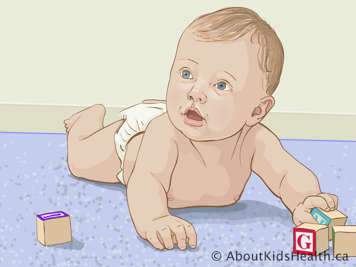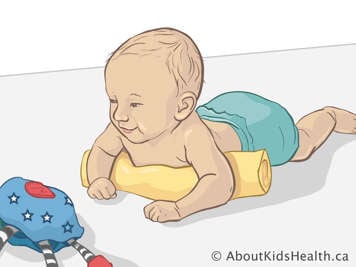What is tummy time?
Your baby should always sleep on their back. This has been shown to reduce the risk of sudden unexpected infant death (SUID). But if a baby spends too much time on their back, it can lead to a condition called positional plagiocephaly. This is when a baby's skull becomes deformed and flattened by spending too much time in the same position. To help prevent head deformities and promote healthy development, you can turn your baby's head to the left or right while they are sleeping. When your baby is awake and supervised, you can position them on their stomach. Babies should spend a total of about 1.5 hours (90 minutes) every day on their tummies. Remember, "Back to sleep — tummy to play!"
Benefits of tummy time for your baby

Placing your baby on their tummy has many benefits:
- prevents baby flathead, or deformed skull (positional plagiocephaly)
- helps your baby develop head control
- strengthens the upper body, including back, neck, shoulders, arms and hands
- promotes development of gross motor skills such as crawling, sitting and rolling
- promotes development of fine motor skills and play skills
- promotes sensory development by changing the environment and how your baby sees the world around them
Activities for tummy time

To make sure your baby spends time in a variety of positions, try these activities:
- Position toys on both sides of your baby's head within their field of view. This will help your child learn to turn their head in both directions and give them something fun to look at.
- Place your baby's chest on a rolled towel, cushion or over your knees. This may be more comfortable for your baby. It can also improve upper body strength and head control.
- Lay your baby on your chest while you are lying back. This will help your baby develop head control and upper body strength in a safe and enjoyable position.
Once your baby can lift their head and push up onto their forearms, try these ideas:
- Use mirrors and toys around your baby to encourage weight shifting and reaching. This strengthens the arms, hands and back muscles to prepare your baby for sitting, rolling and crawling.
- Play Peek-A-Boo while you and your baby are both on your tummies. Hold a blanket between you and encourage your baby to pull down the blanket. This game helps strengthen the muscles your baby uses for crawling, sitting and fine motor skills. It also helps with language and with social and mental skills.

Once your baby has good control of their head and is able to sit, try playing "airplane." Lift your baby at the hips and/or waist or rest your baby on your bent legs and move them up and down. This will help strengthen neck and back muscles to allow your baby to lift their head up.
We live in an era where children are consistently placed on their backs: in car seats, in bed and in strollers. Try holding your baby in a variety of positions, including over your knees or chest, to increase tummy time.
Encouraging tummy time with your baby
If your baby dislikes being on their stomach, here are some ways to encourage tummy time:
- Give your baby something fun and interesting to look at, like a toy, a mirror or your face.
- Slowly increase tummy time. Short and frequent tummy time experiences allow your baby to become familiar and feel safe in this position.
- Include short tummy time experiences whenever you change, dress or hold your baby.
- Slowly roll your baby from their back to their tummy. This can be less startling for babies compared to simply placing them on their tummies.
- Firm, flat surfaces can be easier for babies as they learn to use their upper body muscles while playing on their tummies.
